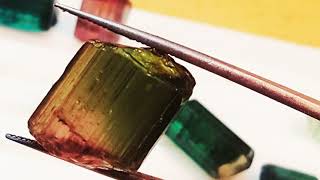Tourmaline Gemstone – Types | Value | Identification & More
Tourmaline Gemstone – Types | Value | Identification & More

You might’ve seen the beautiful #tourmaline in the store, or maybe you’ve seen jewelry with this. But, do you know what this precious stone really is? Listen on to learn a little bit about this.
Tourmaline is more than just a pretty stone, it’s actually crystalline boron silicate mineral that has elements including aluminum, magnesium, iron, potassium, sodium, and lithium. It’s considered a semi-precious stone and it’s also a gemstone that has many different pretty colors.
How this came about was many years ago, this gemstone was brought to Europe through the Dutch east India company because people were curious about these gems. However, people didn’t know that this was a mineral, and it was actually only discovered in the last 400 years. Back in 1703, it was found that the colored gems in this weren’t just normal zircons, but something else.
It’s called the Ceylonese Sri Lankan magnet simply because it’s so pretty it could attract and not repel the harshness of a person, simply due to the pyroelectric properties of this gemstone.
This was also when the use of this gemstone came into fruition. It’s used by chemists starting in the 19th century, where they polarized the light by shining rays into a cut of a polished piece of this gem. Pretty cool, huh?
The name of this came from the word throamalli, or tora-molli which is the name of some gemstones that are found in the subcontinent of India. According to the same sources, this is also derived from the Sinhalese ord. it’s actually in the oxford English dictionary if you want to trace back the full roots of this.
There are different kinds of tourmaline that you can find. The most common is Schorl, which is sodium iron and it’s a divalent member of his group, and it accounts for about 95% of the mineral that occurs in nature, and it was discovered back in the 1400s.
There is also Dravite, which is called brown tourmaline, and it contains sodium magnesium tourmaline, and there are different forms of it. The first person to name this was a man named Gustavo Tschermak, and that as in the 19th century. This one o=us more magnesium-rich than sodium rich, and it isn’t as popular.
Finally, you have elbite, which is one that is more lithium in nature, and this one occurs mostly in Sweden, and on the Elba island in Italy, and it was discovered in 1850.
The color of this does depend on the mineral properties that it has. Those that are iron-rich tend to have more of a black to bluish-black or a deep brown, whereas the magnesium-rich kinds usually have brown to yellow, and the lithium ones come in practically almost every color. There is also a pink version which comes about due to exposed levels of radiation.
There are different types of this type of stone, and they’re used for a variety of different properties. There are some specimens of this in the US, and that was mostly in California, which is where a lot of the deposits are, and they’re known for the raspberry-pink and the minty colors of the gems that are here. Maine, along with California, are the two biggest producers of this, especially the pink tourmaline which you can find a lot in California. Some native
Americans have used this for centuries.
I’s a brilliant, beautiful stone, and as you can see here, there is a lot of variety to these stones that you’ll definitely want to check them out. They’re beautiful, and they offer a lot of variety, and they are certainly some of the most beautiful stones that you can find out there, and they offer a lot of fun uses for everyone.
